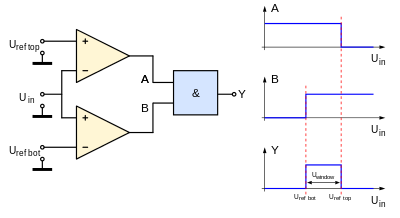Window comparator
| Uin | A. | B. | Y |
|---|---|---|---|
| <U refbot | 1 | 0 | 0 |
| > U reftop | 0 | 1 | 0 |
| <U reftop > U refbot |
1 | 1 | 1 |
A window comparator is an electronic circuit that detects an input voltage at the upper and lower limit value. As shown in the adjacent circuit diagram, it consists of two comparators shown in yellow, which compare the common input voltage U in to their respective reference voltage U ref top , for the upper reference voltage , and U ref bot , for the lower reference voltage .
The logical AND gate , highlighted in blue in the sketch, of the two comparator outputs at points A and B results in the output signal Y and provides information as to whether the input voltage U in is within the two reference limit values - in the so-called "window".
The window discriminator is a window comparator inverted at the output. It hides a tolerance defined as a window . A circuit whose window is the upper and lower switching threshold of the input is the Schmitt trigger .
application
Window comparators are used, among other things, to monitor fill level measurements in an industrial environment, as well as to control devices for refilling, computers and battery voltages .
literature
- Ulrich Tietze, Christoph Schenk: Semiconductor circuit technology . 10th edition. Springer, 1993, ISBN 3-540-56184-6 , pp. 190-191 .
- Ulrich Tietze, Christoph Schenk: Semiconductor circuit technology . 15th edition. Springer, 2016, ISBN 978-3-662-48354-1 , pp. 884-885 .
